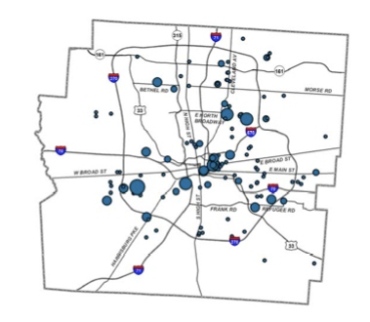Columbus Housing Justice
CHJ testimony to the UN Special Rapporteur on Housing
2 Comments
Raquel Rolnik, the U.N. Special Rapporteur on Housing, is in the United States this week to investigate the US housing crisis. As members of the Poor People’s Economic Human Rights Campaign, Columbus Housing Justice submitted the following written testimony about the demolition of pulic housing in Columbus, OH.
——————-
COLUMBUS HOUSING JUSTICE – COLUMBUS, OHIO
The Problem
In the face of an economic and foreclosure crisis, when the need for affordable housing has never been greater, the city of Columbus is planning to demolish or sell nearly one half of its public housing stock by 2013. The loss of 1,559 units out of the current 3,425 unit total is estimated to affect 4,365 people.
The city plans to relocate the bulk of residents to private-market housing using Section 8 vouchers, though some will be transferred to remaining public housing complexes.
Current residents of public housing slated for demolition have no option to stay in their current housing, and many complain of being given very little detail about their residential fates.
While authorities promote the Section 8 voucher program’s ability to give residents choice over their housing, this ostensible benefit also carries heavy costs that put at risk the human right to safe and secure housing.
First, many residents will have to relocate to areas that are far from their current jobs, access to public transportation, and other downtown amenities. The communities to be demolished or sold are overwhelmingly in the central city area. In contrast, the bulk of landlords who accept Section 8 vouchers are located in outlying areas. Residents who cannot find Section 8 housing downtown, and especially those who do not have cars, will face increased commutes and serious transportation crises that will put their jobs and livelihoods at risk.
Map: HUD multi-family assistance and Section 8 projects by number of units, Columbus OH


Source: Columbus and Franklin County Consolidated Plan 2010-2014
Second, Section 8 housing is significantly less secure than public housing. Columbus already has a waiting list of 9,885 people for Section 8 vouchers. At the same time, the overall supply of Section 8 units is decreasing, down 11,423 units since 1999. It is no help to newly homeless residents of public housing to receive vouchers if there are not enough private units to house them, and if that supply is only decreasing over time. Also, unlike public housing, Section 8 is designed as temporary, rather than long term housing assistance. People are much more likely to lose their Section 8 voucher due to increased compliance and re-certification requirements, expiration, and budget cuts. As the saying goes “it is a lot easier to tear up a voucher than tear down a building.”
Columbus Housing Justice, a member of PPEHRC, sees these changes in public housing as part of the larger process of exclusion and gentrification in Columbus. The majority of complexes set for demolition and private development lie on valuable downtown land. Abandoned in earlier decades by wealthier (and whiter) Ohioans, the city and private interests now want to develop these sites for the use of that same demographic group. This requires the exclusion and relocation of the poor whites and people of color that inhabit downtown public housing. 88% of public housing residents are people of color, and all have low to very low incomes. This number includes a high number of Somali refugees (Columbus has the second highest Somali concentration of any American city).
Fighting Back
Columbus Housing Justice believes that the destruction of downtown public housing constitutes the destruction of valuable historical landmarks, cultural enclaves, and community ties among the poor.
To fight the loss of these communities and protect the human right to housing, CHJ is organizing residents of the city’s largest public housing community (Poindexter Village) to articulate demands for greater information, control over their destinies, and the preservation of public housing stock in downtown Columbus. Our efforts are slowly expanding to include residents of Riverside-Bradley, another public housing community.
Poindexter Village, a 432 unit community, was built in 1932. It was one of the first three public housing projects in the country and was inaugurated by Franklin D. Roosevelt. It was built on the former site of the “Blackberry Patch”, a shanty-town that was home to many poor southern blacks who migrated north through the turn of the century. After its construction, Poindexter Village continued to be a hub of southern black culture in Columbus. The community takes its name from a famous local slave abolitionist, and one of the city’s world-renowned artists, Aminah Robinson, grew up in Poindexter and drew on its rich cultural legacy to make her artwork.

Poindexter Village, First Families in 1940 by Aminah Robinson
CHJ has formed a residents’ group in Poindexter that will hold its first Town Hall Meeting in December to begin articulating a list of demands to the Columbus Metropolitan Housing Authority. We have also submitted video testimony to the Columbus City Council, critiquing the city’s consolidated plan for its lack of concern for the housing rights of the poor.
This video testimony can be viewed online here:
Testimony of Laura, of Columbus Housing Justice
Testimony of Lorraine Astrop-Scroggins, Riverside-Bradley resident
Testimony of Danielle Lawrence, Poindexter Village resident
Testimony of Sherry & George Truex, Poindexter Village residents